Limnoperna fortunei
Limnoperna fortunei, the golden mussel, is a medium-sized freshwater bivalve mollusc of the family Mytilidae. The native range of the species is China, but it has accidentally been introduced to South America and several Asian countries where it has become an invasive species. It is considered to be an ecosystem engineer because it alters the nature of the water and the bottom habitats of lakes and rivers and modifies the associated invertebrate communities. It also has strong effects on the properties of the water column, modifying nutrient proportions and concentrations, increasing water transparency, decreasing phytoplankton and zooplankton densities, on which it feeds, and enhancing the growth of aquatic macrophytes. Because mussels attach to hard substrata, including the components of industrial, water-treatment and power plants, they have become a major biofouling problem in the areas invaded.
| Golden mussel | |
|---|---|
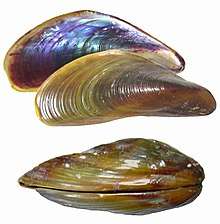 | |
| Scientific classification | |
| Kingdom: | Animalia |
| Phylum: | Mollusca |
| Class: | Bivalvia |
| Order: | Mytilida |
| Family: | Mytilidae |
| Genus: | Limnoperna |
| Species: | L. fortunei |
| Binomial name | |
| Limnoperna fortunei (Dunker, 1857) [1] | |
| Synonyms[1] | |
| |
Description
The larvae of the golden mussel are small (around 100 micrometers), and live in the water column until they are ready to settle. The size of adult individuals is usually around 20–30 mm in length, but specimens up to over 45 mm have been reported. The outer surface of the shell is golden to dark brown, whereas internally it is nacreous, pearly white to purple. The valves are very thin and brittle, and there are no hinge teeth. The mantle is fused on the dorsal side and between the exhalant siphon and the inhalant aperture. Water enters the mussel's mantle cavity through the inhalant aperture, and after describing a series of movements during which suspended particles are filtered out and either ingested, digested in the gut, and the undigested remains egested as feces, or discarded as pseudofeces, is expelled through the exhalant siphon. These water currents are also used for respiration and for discarding excretion waste products. The shell attaches to hard substrates by byssal threads, forming beds of closely packed animals. Internally, a series of muscles attached to the valves are responsible for its closure, retraction of the byssus, and movements of the foot[2][3]
Reproduction, growth and life cycle
Limnoperna fortunei is dioecious, with approximately equal numbers of males and females and very small proportions of hermaphrodites.[4] Sexual maturation occurs early, at about 5–6 mm.[5] Ova and sperm are liberated into the water, most probably simultaneously within the same area, where fertilization occurs producing a series of planktonic developing forms including a trochophore and a veliger around 150 micrometers in size. The final larval stage before settling on a substrate, which takes between 20 days (at 20 °C) and 12 days (at 28 °C) is the plantigrade larva (~250 micrometers).[6][7] The reproductive cycle has been described for both Asian and South American populations, and is clearly associated with water temperature. In South America, at water temperatures between ~10 and 30 °C, larvae are produced continuously for 6–10 months of the year between spring and autumn, often with conspicuous peaks around November and April.[8] In Japan, at water temperatures around 5-20 °C, larval production is restricted to 1–2 summer months.[9] Larval densities during the reproductive period are very variable, but normally average around 6000 larvae per cubic meter of water, although values in excess of 20000 larvae per cubic meter of water have been reported.[8] In waterbodies where strong cyanobacterial blooms occur, reproduction can be suppressed altogether because cyanobacterial toxins (microcystin) engender massive larval mortalities.[10]
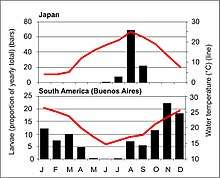
The golden mussel's life span is around 2 years. Growth is fastest during the summer, decreasing sharply in winter. During the first year mussels typically grow to ~20 mm, reaching ~25–30 mm at the end of the second year. Growth rates and final size depend largely on water temperature and the time of the year when the individuals are born, although calcium concentrations, pollution, food availability and intraspecific competition may play important roles as well.[11][12][13][14]
Distribution and geographic spread

L. fortunei's native range is most probably the Pearl River basin, in southern China. Its presence in Laos, Cambodia, Thailand and Vietnam is probably the result of historical human migrations.[15] Between 1965 and 1990, it spread into Hong Kong, Korea, Taiwan and Japan.[16][17] Around 1990 it appeared in Argentina.[18] By 2006 it had spread to Uruguay, Paraguay, Bolivia, and Brazil. In 2017, in South America it was present in two major basins (Río de La Plata, including the Paraguay-Paraná and Uruguay rivers, and the São Francisco basin), as well as several smaller watersheds (Mar Chiquita, Guaíba, Patos-Mirim, Tramandaí).[19][20] Its spread northwards in South America (Amazon, Orinoco, Magdalena basins), as well as into Central and southern North America, seems very likely.[21][22][23][24]
Ecology and environmental impacts
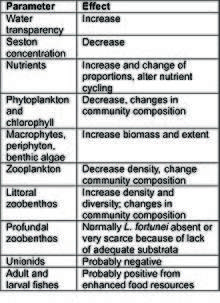
L. fortunei is a strictly freshwater species, although it can tolerate brackish waters of up to 23 per mil (23 grams of salt per liter of water) for restricted periods of time (hours).[25]
The mussel needs hard substrata for settling, like rocks, wood, floating and submerged plants, mussel shells, crustaceans, etc. Although it cannot live on fine loose sediments, muddy areas stabilized by roots or fibrous debris are also occasionally colonized.[26][27] Because in most waterbodies colonies are intensively preyed upon (mostly by fishes), colonization is often restricted to crevices inaccessible to large predators. Mussel beds cover extensive areas at densities often in excess of 200,000 animals (including early juveniles below 1 mm in size) per square meter, but their thickness rarely exceeds 7–10 cm, with most adults being at least partially attached to the substrate. Settlement of new recruits is higher in established mussel beds than elsewhere, and juveniles often attach to larger shells, but eventually move deeper towards the substrate.[26][28] The very few surveys on population densities over large areas reported around 1000 mussels per square meter.[27][29] In lakes, reservoirs and rivers, mussel colonization is often restricted to coastal areas, where hard substrata are more abundant because loose sediments are winnowed away from these higher energy zones towards deeper areas.
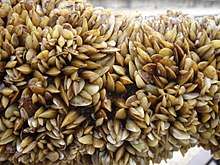
The golden mussel is a filter-feeder. Adult individuals process around 1 liter of water every 10 hours,[30] retaining organic particles, including phytoplankton and zooplankton, and egesting or rejecting unwanted materials in mucous strands that settle on the bottom. The effects of this process on the water column include the decrease of suspended particles, water column primary production, and the concomitant increase in water transparency. which in turn enhances the growth of submerged macrophytes.[30] Further, nutrient (ammonia, nitrate, phosphate) concentrations in the water are increased, favoring the growth of often toxic cyanobacteria.[31] Bottom deposits and the sediments retained among the mussels are enriched with organic matter. Benthic organisms and those that feed on detritus in general, including many fish species, benefit from this additional source of energy. Benthic invertebrates, in particular, are usually more diverse and abundant in mussel beds than elsewhere.[32]
In South America, adult L. fortunei is preyed upon by at least 50 fish species.[33] Introduction of this mussel in South America has been tentatively associated with large increases in the landings of the commercially most important detritivorous fish species of the Río de la Plata basin, Prochilodus lineatus.[34] In Argentina and in Japan, up to over 90% of the mussel's production is lost to predation,[35][36] mostly presumably by fishes, but also probably by other invertebrates, waterfowl, turtles, and mammals.[35] In South America, the planktonic larvae of the golden mussel are actively consumed by fish larvae of ~20 species, especially from the orders Characiformes and Siluriformes. This diet has been shown to significantly improve fish growth, especially during the earliest developmental stages.[37][38][39]
The evidence of whether these impacts are positive or negative for the ecosystems invaded is mixed and debatable. This issue is further complicated by the fact that the same forcing can have opposite results. For example, while the provision of organic matter from the mussel's feces and pseudofeces and the protection conveyed by its colonies can enhance the abundance and diversity of benthic invertebrates, this extra load of organic matter can also deplete near-bottom oxygen levels, thus decreasing the abundance and diversity of benthic invertebrates.[40]
Impacts on human activities
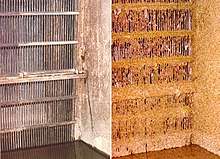
As opposed to its effects on the environment, those on man-made structures are clearly negative. The mussel has caused severe fouling problems in both Asia and in South America. The facilities affected include power plants (nuclear, hydroelectric, thermal), water and wastewater processing plants, refineries, steel mills, fish culture installations, water transfer canals and aqueducts, watercraft, agricultural irrigation systems, balancing reservoirs and balancing tanks. The plant components that are most commonly fouled by the mussels are pipes, heat exchangers and condensers, strainers, filters, trash racks, grates, screens, penstocks, pumps, nozzles, and sprinklers, vent lines, and air release valves, fire protection equipment, grit chambers, flocculators, holding ponds, storage tanks, pump suction chambers, pump wells, water intake tunnels, pump and turbine shafts, seals, and wear rings, boat engines (cooling water ducts, filters, pumps) and submerged rudder and propulsion components, sand filtration systems, submerged monitoring instrumentation, and level gauges. The problems involved include clogging by living mussels or by dead, dislodged shells, pressure loss, overheating, corrosion, abrasion and wear, jamming of moving components, sealing failures, deterioration of metal, concrete and other materials, and sediment accumulation.[41] However, objective estimates of the economic losses involved are practically unavailable. Fouling by L. fortunei has not caused a single definitive plant shutdown. Nevertheless, operation at below-standard regimes and even temporary plant shutoffs have often been reported. Numerous fouling control methods have been proposed and tested, either in laboratory conditions only, or in actual operating environments. These include antifouling materials and coatings, manual/mechanical cleaning, filtration, chemical treatments, thermal shock, anoxia and hypoxia, desiccation, ozonation, ultraviolet treatment, electric currents, ultrasound, manipulations of flow speed, biological control, and various miscellaneous methods[42][43][44][45][46][47][48][49][50].
References
- Huber, Markus (2010). Bieler R, Bouchet P, Gofas S, Marshall B, Rosenberg G, La Perna R, Neubauer TA, Sartori AF, Schneider S, Vos C, ter Poorten JJ, Taylor J, Dijkstra H, Finn J, Bank R, Neubert E, Moretzsohn F, Faber M, Houart R, Picton B, Garcia-Alvarez O (eds.). "Limnoperna fortunei (Dunker, 1857)". MolluscaBase. World Register of Marine Species. Retrieved 2012-04-21.
- Morton, Brian (2015). "The Biology and Anatomy of Limnoperna fortunei, a Significant Freshwater Bioinvader: Blueprints for Success". Limnoperna Fortunei. Invading Nature - Springer Series in Invasion Ecology. Springer, Cham. pp. 3–41. doi:10.1007/978-3-319-13494-9_1. ISBN 9783319134932.
- Morton, Brian (1973). "Some aspects of the biology and functional morphology of the organs of feeding and digestion of Limnoperna fortunei (Dunker) (Bivalvia: Mytilacea)". Malacologia. 12: 265–281.
- Darrigran, G.; Damborenea, C.; Penchaszadeh, P.E. (1998). "A case of hermaphroditism in the freshwater invading bivalve Limnoperna fortunei (Dunker, 1857) (Mytilidae) from Río de la Plata, Argentina". Iberus. 16: 99–104.
- Darrigran, G.; Penchaszadeh, P.E.; Damborenea, C. (1999). "The reproductive cycle of Limnoperna fortunei (Dunker, 1857) (Mytilidae) from a neotropical temperate locality". Journal of Shellfish Research. 18: 361–365.
- Cataldo, Daniel; Boltovskoy, Demetrio; Hermosa, Jose L.; Canzi, Carla (2005-02-01). "Temperature-Dependent Rates Of Larval Development In Limnoperna Fortunei (Bivalvia: Mytilidae)". Journal of Molluscan Studies. 71 (1): 41–46. doi:10.1093/mollus/eyi005. ISSN 0260-1230.
- Cataldo, Daniel H. (2015). "Larval Development of Limnoperna Fortunei". Limnoperna Fortunei. Invading Nature - Springer Series in Invasion Ecology. Springer, Cham. pp. 43–53. doi:10.1007/978-3-319-13494-9_2. ISBN 9783319134932.
- Boltovskoy, Demetrio; Morton, Brian; Correa, Nancy; Cataldo, Daniel; Damborenea, Cristina; Penchaszadeh, Pablo E.; Sylvester, Francisco (2015). Limnoperna Fortunei (PDF). Invading Nature - Springer Series in Invasion Ecology. Springer, Cham. pp. 77–103. doi:10.1007/978-3-319-13494-9_5. ISBN 9783319134932.
- Nakano, Daisuke; Kobayashi, Takuya; Sakaguchi, Isamu (2010-01-01). "Differences in larval dynamics of golden mussel Limnoperna fortunei between dam reservoirs with and without an aeration system". Landscape and Ecological Engineering. 6 (1): 53. doi:10.1007/s11355-009-0082-7. ISSN 1860-1871.
- Boltovskoy, Demetrio; Correa, Nancy; Bordet, Facundo; Leites, Valentín; Cataldo, Daniel (2013-09-01). "Toxic Microcystis (cyanobacteria) inhibit recruitment of the bloom-enhancing invasive bivalve Limnoperna fortunei". Freshwater Biology. 58 (9): 1968–1981. doi:10.1111/fwb.12184. ISSN 1365-2427.
- Nakano, Daisuke; Kobayashi, Takuya; Sakaguchi, Isamu (2015). Limnoperna Fortunei. Invading Nature - Springer Series in Invasion Ecology. Springer, Cham. pp. 105–118. doi:10.1007/978-3-319-13494-9_6. ISBN 9783319134932.
- Boltovskoy, Demetrio; Cataldo, Daniel H. (1999-12-01). "Population dynamics of Limnoperna fortunei, an invasive fouling mollusc, in the lower Parana river (Argentina)". Biofouling. 14 (3): 255–263. doi:10.1080/08927019909378417. ISSN 0892-7014.
- Morton, B. (1977). "The population dynamics of Limnoperna fortunei (Dunker 1857) (Bivalvia: Mytilacea) in Plover Cove Reservoir, Hong Kong". Malacologia. 16: 165–182.
- Maroñas, M. E.; Darrigran, G. A.; Sendra, E. D.; Breckon, G. (2003-03-01). "Shell growth of the golden mussel, Limnoperna fortunei (Dunker, 1857) (Mytilidae), in the Río de la Plata, Argentina". Hydrobiologia. 495 (1–3): 41–45. doi:10.1023/a:1025463523364. ISSN 0018-8158.
- Morton, B.; Dinesen, G. (2010). "Colonization of Asian freshwaters by the Mytilidae (Bivalvia): A comparison of Sinomytilus harmandi from the Tonle-Sap River, Phnom Penh, Cambodia, with Limnoperna fortunei". Molluscan Research. 30: 57–72.
- Xu, Mengzhen (2015). "Distribution and Spread of Limnoperna fortunei in China". Limnoperna Fortunei. Invading Nature - Springer Series in Invasion Ecology. Springer, Cham. pp. 313–320. doi:10.1007/978-3-319-13494-9_17. ISBN 9783319134932.
- Ito, Kenji (2015). "Colonization and Spread of Limnoperna fortunei in Japan". Limnoperna Fortunei. Invading Nature - Springer Series in Invasion Ecology. Springer, Cham. pp. 321–332. doi:10.1007/978-3-319-13494-9_18. ISBN 9783319134932.
- Pastorino, G.; Darrigran, G.; Martín, S.M.; Lunaschi, L. (1993). "Limnoperna fortunei (Dunker, 1857) (Mytilidae), nuevo bivalvo invasor en aguas del Río de la Plata". Neotropica. 39: 101–102.
- Oliveira, Marcia D.; Campos, Mônica C. S.; Paolucci, Esteban M.; Mansur, Maria C. D.; Hamilton, Stephen K. (2015). Limnoperna Fortunei. Invading Nature - Springer Series in Invasion Ecology. Springer, Cham. pp. 333–355. doi:10.1007/978-3-319-13494-9_19. ISBN 9783319134932.
- Barbosa, Newton P. U.; Silva, Fabiano A.; Oliveira, Márcia Divina De; Neto, Miguel Arcanjo dos Santos; Carvalho, Marcela David De; Cardoso, Antônio Valadão (2016-02-23). "Limnoperna fortunei (Dunker, 1857) (Mollusca, Bivalvia, Mytilidae): first record in the São Francisco River basin, Brazil". Check List. 12 (1): 1846. doi:10.15560/12.1.1846. ISSN 1809-127X.
- Campos, Mônica; Andrade, André Felipe Alves de; Kunzmann, Bárbara (2014). "Modelling of the potential distribution of Limnoperna fortunei (Dunker, 1857) on a global scale". Aquatic Invasions. 9 (3): 253–265. doi:10.3391/ai.2014.9.3.03.
- Kluza, D.A.; McNyset, K.M. (2005). "Ecological niche modeling of aquatic invasive species". Aquatic Invaders. 16: 1–7.
- Karatayev, Alexander Y.; Boltovskoy, Demetrio; Burlakova, Lyubov E.; Padilla, Dianna K. (2015). Limnoperna Fortunei. Invading Nature - Springer Series in Invasion Ecology. Springer, Cham. pp. 261–297. doi:10.1007/978-3-319-13494-9_15. ISBN 9783319134932.
- Mackie, Gerald; Brinsmead, Jeff (2017). "A risk assessment of the golden mussel, Limnoperna fortunei (Dunker, 1857) for Ontario, Canada". Management of Biological Invasions. 8 (3): 383–402. doi:10.3391/mbi.2017.8.3.12.
- Sylvester, Francisco; Cataldo, Daniel H.; Notaro, Carolina; Boltovskoy, Demetrio (2013-06-01). "Fluctuating salinity improves survival of the invasive freshwater golden mussel at high salinity: implications for the introduction of aquatic species through estuarine ports". Biological Invasions. 15 (6): 1355–1366. doi:10.1007/s10530-012-0373-z. hdl:11336/736. ISSN 1387-3547.
- Correa, Nancy; Sardiña, Paula; Perepelizin, Pablo V.; Boltovskoy, Demetrio (2015). Limnoperna Fortunei. Invading Nature - Springer Series in Invasion Ecology. Springer, Cham. pp. 119–143. doi:10.1007/978-3-319-13494-9_7. ISBN 9783319134932.
- Musin, Gabriela E.; Molina, Florencia Rojas; Giri, Federico; Williner, Verónica (2015-04-13). "Structure and density population of the invasive mollusc Limnoperna fortunei associated with Eichhornia crassipes in lakes of the Middle Paraná floodplain". Journal of Limnology. 74 (AoP). doi:10.4081/jlimnol.2015.1107.
- Sardiña, Paula; Cataldo, Daniel H.; Boltovskoy, Demetrio (2009-12-01). "Effects of conspecifics on settling juveniles of the invasive golden mussel, Limnoperna fortunei". Aquatic Sciences. 71 (4): 479–486. doi:10.1007/s00027-009-0103-5. ISSN 1015-1621.
- Boltovskoy, Demetrio; Karatayev, Alexander; Burlakova, Lyubov; Cataldo, Daniel; Karatayev, Vadim; Sylvester, Francisco; Mariñelarena, Alejandro (2009-12-01). "Significant ecosystem-wide effects of the swiftly spreading invasive freshwater bivalve Limnoperna fortunei". Hydrobiologia. 636 (1): 271–284. doi:10.1007/s10750-009-9956-9. ISSN 0018-8158.
- Boltovskoy, Demetrio; Correa, Nancy; Sylvester, Francisco; Cataldo, Daniel (2015). Limnoperna Fortunei. Invading Nature - Springer Series in Invasion Ecology. Springer, Cham. pp. 153–176. doi:10.1007/978-3-319-13494-9_9. ISBN 9783319134932.
- Cataldo, Daniel; Vinocur, Alicia; O′Farrell, Inés; Paolucci, Esteban; Leites, Valentín; Boltovskoy, Demetrio (2012-01-01). "The introduced bivalve Limnoperna fortunei boosts Microcystis growth in Salto Grande reservoir (Argentina): evidence from mesocosm experiments". Hydrobiologia. 680 (1): 25–38. doi:10.1007/s10750-011-0897-8. ISSN 0018-8158.
- Sylvester, Francisco; Sardiña, Paula (2015). Limnoperna Fortunei. Invading Nature - Springer Series in Invasion Ecology. Springer, Cham. pp. 191–210. doi:10.1007/978-3-319-13494-9_11. ISBN 9783319134932.
- Cataldo, Daniel (2015). "Trophic Relationships of Limnoperna Fortunei with Adult Fishes". Limnoperna Fortunei. Invading Nature - Springer Series in Invasion Ecology. Springer, Cham. pp. 231–248. doi:10.1007/978-3-319-13494-9_13. ISBN 9783319134932.
- Boltovskoy, Demetrio; Correa, Nancy; Cataldo, Daniel; Sylvester, Francisco (2006-06-01). "Dispersion and Ecological Impact of the Invasive Freshwater Bivalve Limnoperna fortunei in the Río de la Plata Watershed and Beyond". Biological Invasions. 8 (4): 947–963. doi:10.1007/s10530-005-5107-z. ISSN 1387-3547.
- Sylvester, Francisco; Boltovskoy, Demetrio; Cataldo, Daniel (2007-09-01). "The invasive bivalve Limnoperna fortunei enhances benthic invertebrate densities in South American floodplain rivers". Hydrobiologia. 589 (1): 15–27. doi:10.1007/s10750-007-0708-4. ISSN 0018-8158.
- Nakano, Daisuke; Kobayashi, Takuya; Sakaguchi, Isamu (2010-12-01). "Predation and depth effects on abundance and size distribution of an invasive bivalve, the golden mussel Limnoperna fortunei, in a dam reservoir". Limnology. 11 (3): 259–266. doi:10.1007/s10201-010-0314-4. ISSN 1439-8621.
- Paolucci, Esteban M.; Thuesen, Erik V. (2015). Limnoperna Fortunei. Invading Nature - Springer Series in Invasion Ecology. Springer, Cham. pp. 211–229. doi:10.1007/978-3-319-13494-9_12. ISBN 9783319134932.
- Paolucci, Esteban M.; Thuesen, Erik V.; Cataldo, Daniel H.; Boltovskoy, Demetrio (2010-09-01). "Veligers of an introduced bivalve, Limnoperna fortunei, are a new food resource that enhances growth of larval fish in the Paraná River (South America)". Freshwater Biology. 55 (9): 1831–1844. doi:10.1111/j.1365-2427.2010.02418.x. ISSN 1365-2427.
- Paolucci, Esteban M.; Cataldo, Daniel H.; Boltovskoy, Demetrio (2010-03-01). "Prey selection by larvae of Prochilodus lineatus (Pisces: Curimatidae): indigenous zooplankton versus veligers of the introduced bivalve Limnoperna fortunei (Bivalvia: Mitilidae)". Aquatic Ecology. 44 (1): 255–267. doi:10.1007/s10452-009-9263-6. ISSN 1386-2588.
- Boltovskoy, Demetrio (2017-10-30). "Traits and impacts of invasive species: Myths and evidences from the perspective of introduced freshwater Mussels". Aquatic Ecosystem Health & Management. 0 (ja): 00. doi:10.1080/14634988.2017.1397483. ISSN 1463-4988.
- Boltovskoy, Demetrio; Xu, Mengzhen; Nakano, Daisuke (2015). Limnoperna Fortunei. Invading Nature - Springer Series in Invasion Ecology. Springer, Cham. pp. 375–393. doi:10.1007/978-3-319-13494-9_21. ISBN 9783319134932.
- Claudi, Renata; Oliveira, Marcia Divina de (2015). Limnoperna Fortunei. Invading Nature - Springer Series in Invasion Ecology. Springer, Cham. pp. 417–441. doi:10.1007/978-3-319-13494-9_23. ISBN 9783319134932.
- Claudi, Renata; Oliveira, Marcia Divina de (2015). Limnoperna Fortunei. Invading Nature - Springer Series in Invasion Ecology. Springer, Cham. pp. 463–476. doi:10.1007/978-3-319-13494-9_27. ISBN 9783319134932.
- Mackie, Gerald; Claudi, Renata (2009). Taylor & Francis Group. doi:10.1201/9781439804414. ISBN 978-1-4398-0050-8.
- Perepelizin, Pablo V.; Boltovskoy, Demetrio (2011-09-15). "Hot Water Treatment (Chronic Upper Lethal Temperature) Mitigates Biofouling by the Invasive Asian Mussel Limnoperna fortunei in Industrial Installations". Environmental Science & Technology. 45 (18): 7868–7873. doi:10.1021/es2014852. ISSN 0013-936X. PMID 21842855.
- Perepelizin, P.V.; Boltovskoy, D. (2011). "Resistance of the invasive pest mussel Limnoperna fortunei to anoxia". Journal of the American Water Works Association. 103: 79–85. doi:10.1002/j.1551-8833.2011.tb11422.x.
- Perepelizin, Pablo V.; Boltovskoy, Demetrio (2011-06-22). "Thermal tolerance of Limnoperna fortunei to gradual temperature increase and its applications for biofouling control in industrial and power plants". Biofouling. 27 (6): 667–674. doi:10.1080/08927014.2011.594504. ISSN 0892-7014. PMID 21985294.
- Zhang, Chendi; Xu, Mengzhen; Wang, Zhaoyin; Liu, Wei; Yu, Dandan (2017). "Experimental study on the effect of turbulence in pipelines on the mortality of Limnoperna fortunei veligers". Ecological Engineering. 109: 101–118. doi:10.1016/j.ecoleng.2017.08.024.
- Matsui, Yoshihiko; Nagaya, Keiji; Funahashi, Goro; Goto, Yoshinori; Yuasa, Akira; Yamamoto, Hiroyuki; Ohkawa, Kousaku; Magara, Yasumoto (2002-01-01). "Effectiveness of Antifouling Coatings and Water Flow in Controlling Attachment of the Nuisance Mussel Limnoperna fortunei". Biofouling. 18 (2): 137–148. doi:10.1080/08927010290032395. ISSN 0892-7014.
- Matsui, Yoshihiko; Nagaya, Keiji; Yuasa, Akira; Naruto, Hiroshi; Yamamoto, Hiroyuki; Ohkawa, Kousaku; Magara, Yasumoto (2001-04-01). "Attachment Strength of Limnoperna fortunei on Substrates, and their Surface Properties". Biofouling. 17 (1): 29–39. doi:10.1080/08927010109378462. ISSN 0892-7014.
External links
| Wikimedia Commons has media related to Limnoperna fortunei. |
- Darrigran G, Damborenea C (eds) (2006) Bioinvasión del mejillón dorado en el continente americano. Editorial Universitaria de La Plata, La Plata (Argentina), pp 1–221
- Mackie GL, Claudi R (2010) Monitoring and control of macrofouling mollusks in fresh water systems. CRC Press, Boca Raton (USA), pp 1–508
- Mansur MCD, Santos CP, Pereira D, Padula Paz IC, Leite Zurita ML, Raya Rodriguez MT, Vilar Nehrke M, Aydos Bergonci PE (eds) (2012) Moluscos límnicos invasores no Brasil. Biologia, prevenção, controle. Redes Editora, Porto Alegre (Brazil), pp 1–411
- Boltovskoy D (ed) (2015) Limnoperna fortunei: the ecology, distribution and control of a swiftly spreading invasive fouling mussel Springer International Publishing, Cham (Switzerland), pp 1–476
- Species Profile – Golden Mussel (Limnoperna fortunei), National Invasive Species Information Center, United States National Agricultural Library